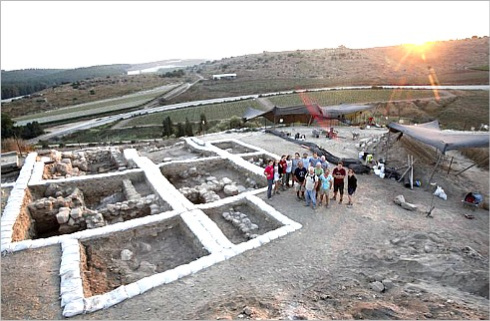Archives
AND MORE...

Remarkable Discovery In Jerusalem
_____________________

For 'Low-Info' Voters
_____________________

Some Inconvenient Facts
_____________________

United Dregs of Humanity
_____________________
August 24, 2020
Canaanite Fortress
A Canaanite fortress was recently unearthed during an excavation by a team of Israeli archeologists from the Israel Antiquities Authority near Kibbutz Gal-On in southern Israel, according to a statement by the Antiquities Authority. It's likely the fortress was built some 3,200 years ago to protect the local Canaanite inhabitants from foreign incursions by the Philistines (see below).
The Philistines, who are believed to be from the island of Crete, although their origins are disputed, inhabited the Mediterranean coast of Canaan during the period of the Book of Judges, and their highly-developed weapons brought a great threat to the Israelites.
The fortress unearthed will allow archeologists "to glimpse into the geopolitical environment depicted in the Book of Judges, in which Canaanite, Israelites and Philistines were clashing with each other," according to archaeologists from the Antiquities Authority.
Jerusalem Post | August 24, 2020
A 12th Century Canaanite Fortress Excavated Near Gal On Opens To Public
By Daniel Nisinman

A team of archaeologists, led by Prof. Yosef Garfinkel of the Hebrew University of Jerusalem's Institute of Archaeology and Prof. Michael Hasel at Southern Adventist University in Tennessee, revealed extensive ruins of a Canaanite temple dating. (photo credit: Courtesy)
It is likely that the fortress was build some 3,200 years ago to protect the local Canaanite inhabitants from foreign incursions, possibly from the Philistines.
A Canaanite fortress, dated to the 12th century BC, the time of the Biblical Judges, was unearthed during an excavation by archaeologist from Israel Antiquities Authority near Kibbutz Gal On in southern Israel, according to a statement by the Antiquities Authority.
It is likely that the fortress was built some 3,200 years ago to protect the local Canaanite inhabitants from foreign incursions, possibly from the Philistines.
The Philistines, whose origins are disputed, came to the biblical land of Canaan in the 12th century BC, sometime around the time Israelites began to settle.
They began settling along the coastline, erecting cities - some of which still stand today - including Ashdod, Ashkelon, Ekron and Gat spreading further south.
Archeologists believe that the fortress was built in an attempt to curb the Philistine's imperialist aspirations.
"The fortress that we unearthed allows us to glimpse into the geopolitical environment depicted in the Book of Judges, in which Canaanite, Israelites and Philistines were clashing with each other," explains Saar Ganon and Itamar Wesbin, both archeologists working for the Antiquities Authority.
The fortress resembles a square of roughly the size of 18 by 18 meters (5.4 ft by 5.4 ft), with a watch tower at each corner. The threshold was carved out of a solid rock, weighing some 3 tons (6,000 pounds).
The inner court was covered by stone plates with columns placed at the centers. Rooms, which served as living quarters and storehouses, were situated on both sides of the court.
In these inner chambers, thousands of pieces of earthenware were discovered. Some of them, however, were remarkably left intact.
Archaeologists believe that they were used for worshiping local gods.
The ancient site will be open to visitors starting from August 25th.
Original article here.
Log In »
Notable Quotables
"Mr. Netanyahu is one of the most media-savvy politicians on the planet. On Friday he appeared live via video link on 'Real Time with Bill Maher,' taking the host’s alternately sardonic and serious line of questioning with gazelle-like alacrity."
~ Anthony Grant, jourrnalist who has written for many major newspapers and worked in television at Paris and Tel Aviv, interviewing former PM Benjamin Netanyahu on Monday, at the outset of Mr. Netanyahu's new book (more here).


